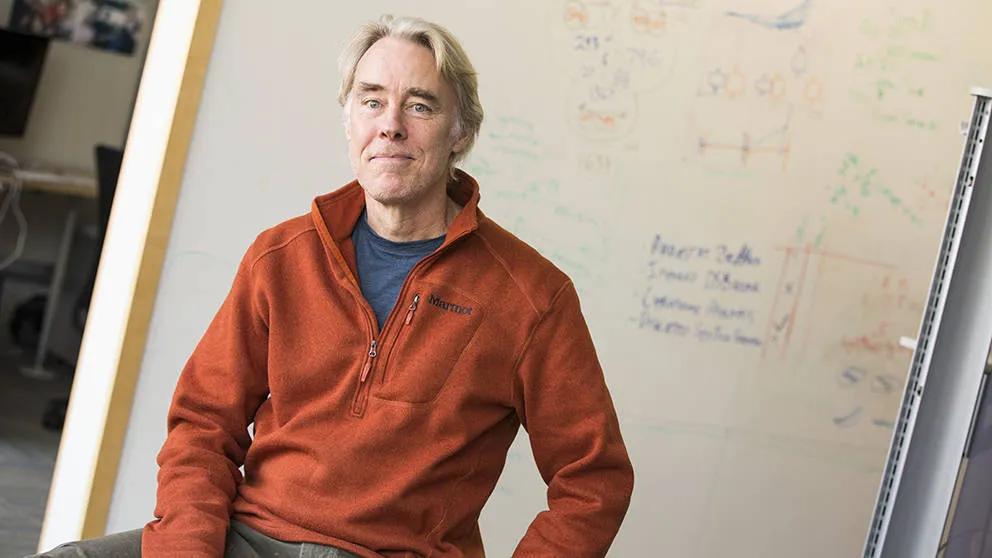Why and how we age
The Search Magazine Article | September 7, 2021
Aging is inevitable, but can the diseases of aging be thwarted or at least postponed? New tools, including genetically varied mouse populations and advanced imaging technologies, hold promise for untangling the myriad mechanisms of human aging.
The Jackson Laboratory makes these and other tools available to the worldwide aging research community, with support from the National Institute on Aging. JAX has one of six NIA-funded Nathan Shock Centers of Excellence in the Basic Biology of Aging, and the grant has been renewed for a total of $5,347,630 over five years.
“The JAX Shock Center has been a resource for the geroscience community for more than a decade,” says JAX Associate Professor Ron Korstanje, Ph.D., co-director of the center. “We provide data and samples from our studies, but most importantly, we offer a pilot project program for investigators.”
Twice a year, the JAX center puts out a request for applications for pilot projects, Korstanje explains. “We get about 15 to 20 applications per round. We select the best of those and work with the investigators to conduct the experiments at JAX, providing the preliminary data they can use for grant proposals or papers.” In some cases, JAX invites participating investigators with special expertise to come to JAX for the duration of their experiments.
Understanding genetic diversity
For decades, mice have been essential to aging research. Lifelong studies are practical in an animal that lives an average of two years in laboratory care. And as fellow mammals, mice and humans share the genetic code that both enables life and programs its eventual deterioration.
Until recently, JAX Shock Center aging studies have been conducted with the world’s most widely used inbred strain of laboratory mouse, the famous C57BL/6J “Black 6” mouse. The Black 6 genome was the first to be sequenced after the human genome, and more is known about the biology of this mouse strain than any other. However, even the mighty Black 6 has limitations: Its very genetic uniformity means that it represents only a sliver of potential genetic variations.
To better represent humans with all their genetic variability, in the early 2000s an international research team, including JAX Shock Center Co-Director Professor Gary Churchill, Ph.D., developed the Collaborative Cross and the Diversity Outbred mouse populations by intercrossing genetically defined mouse strains. The mice from the CC and DO populations are genetically diverse and, in the case of the DO mice, unique individuals, like each human.

Gary Churchill, Ph.D., has spent the last five years aging a large cohort of genetically diverse outbred mice with startling results. A few hardy females from this group appear to have won the genetic lottery, and will soon reach the ripe of age (for mice) of 4.5 years—over twice the normal life span of a laboratory mouse, or roughly equivalent to a 180-year-old human. JAX photo by Tiffany Laufer.
Aged JAX DO colonies have produced some of the longest-lived mice ever recorded, nearly five years, more than twice the average life span of most laboratory mice. These individuals could provide valuable insights into the genetic components of a long and healthy life. The JAX Shock Center has conducted several large studies on DO mice over the past decade, and Korstanje says investigators are now able to submit applications for their own projects using DO mice.
Exploring senolytic drugs
The JAX Shock Center is also launching a project to explore senolytic drugs, a hot topic in aging research. Senolytics target senescent cells, cells that have stopped dividing and are the hallmark of many diseases of aging as well as aging itself. “All studies so far have been performed in just a single inbred strain, Black 6,” Korstanje says, “so there's really nothing known about the effect of these senolytics and genetic variation. Our plan is to do a large intervention study, where we compare one group of aged DO mice that get the senolytics to another group that does not.”
Deploying machine learning
A new Image Analysis Core at the JAX Shock Center will use machine learning to analyze age-related histological profiles. “We're doing this in close collaboration with the Geropathology Research Network,” Korstanje says, “which is an NIA-funded network of pathologists from different universities that are working on standardizing geropathology. Korstanje, whose own lab focuses on age-related kidney diseases, has already launched a study of kidney tissues. “And we're going to expand this to be able to quantify aging lesions in the heart, liver, lung and possibly other tissues.”
Aging and COVID-19
Other planned Shock Center projects include aging colonies of several new mouse models for COVID-19 research currently being developed at JAX. “Aging is an important factor in COVID-19, and we want to provide aged mouse models for the community to do pilot experiments.” The Shock Center at JAX is also collaborating with the one at the University of Washington to support the production of a video lecture series on aging research for use in undergraduate and graduate biology courses.
Preventing blood cancer
Recently the JAX Shock Center convened with the researchers of the National Cancer Institute-funded JAX Cancer Center . JAX Associate Professor Jennifer Trowbridge, Ph.D., who studies age-related blood diseases, notes, “We now understand that the greatest risk factor for cancer development is aging, and yet we know little about why and how aging increases risk of cancer development. We have a unique opportunity at JAX to bring these independent groups of investigators together as a think-tank to tackle these challenging questions.”
Trowbridge notes that her lab bridges these two concepts: “We are actively studying how and why aging of the blood system increases the risk of blood cancers, with the primary goal of identifying intervention strategies to prevent blood cancer development in aging populations.”
Korstanje says he wants the geroscience community to know about all the resources available from the JAX Shock Center. “We can do much more than just provide the aging mice,” he says. “We can be your collaborator to innovate your research programs.”



